One of the small details that often gets overlooked in the art room is whether or not to cover your art tables during art class. You might be wondering:
What type of placemats work best?
Should the whole table be covered in paper? Fabric?
It took me a few years to figure out this placemat thing but when I did, it streamlined my prep and clean up substantially. Today’s episode answers a question from Katie inside the Deep Space Sparkle Facebook Group.
I thought it was such a great question, I decided to go a bit deeper, answering the WHY behind which placemat is best.
Katie asks, Does anyone have an inexpensive way to make clay mats? My budget for the year has been used up, so I’m looking for out-of-pocket affordable solutions. Any cheap and quick ideas?
I totally hear you, Katie!
This episode is for you and all the art teachers who are wondering:
– what type of placemats work best
– when to use placemats
– when NOT to use placemats
– best mats for clay and ceramics
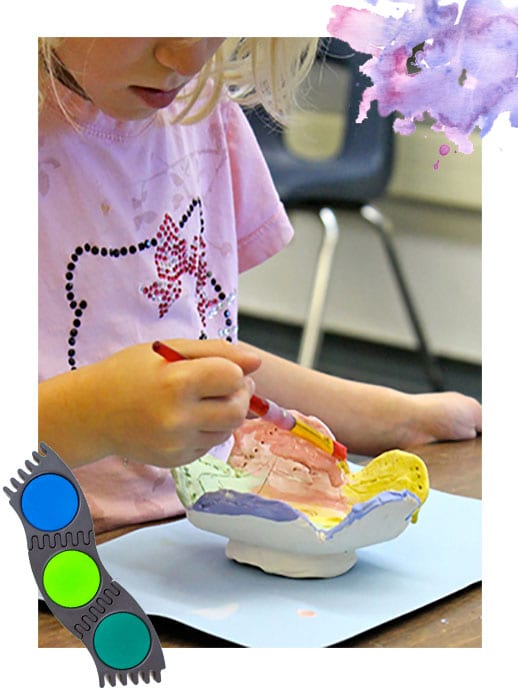
Here’s what other teachers had to say to Katie’s question:
Fiona Coulter I use the cheap but sturdy blue paper drop cloths from the hardware store. One side is more plastic and the other side more paper like. I use the plastic side for clay and the paper side for any painting and drape them over the entire table grouping (8) desks. Works like a charm and lasts a long time.
Laurie O’Connell Longberry I use the plastic flexible cutting mats that you can get 3 for $1 at the dollar store. They last for years!
Tina Leggs Maloch I use a canvas drop cloth from Lowes and cut it into 10 x 12″ pieces – I have been using the same ones for 9 years and they work great.
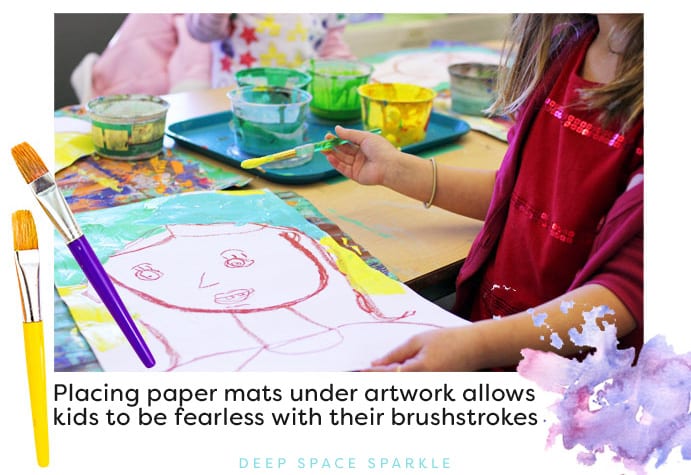
I love the inexpensive version of using what I already have. At the beginning of the year, I would add an extra 50-100 sheets of 18″ x 24″ sulphite paper to my inventory order. This works out to be about $15. I found regular drawing paper works great for underneath most painting and coloring projects.
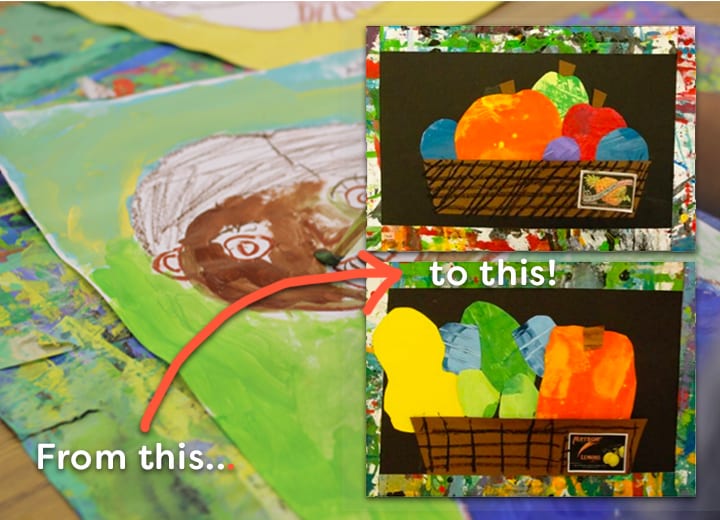
At the end of the year, I would take the paint-splattered placemats and cut them into strips and shapes. These because extra media for collage and paper projects for the following year.
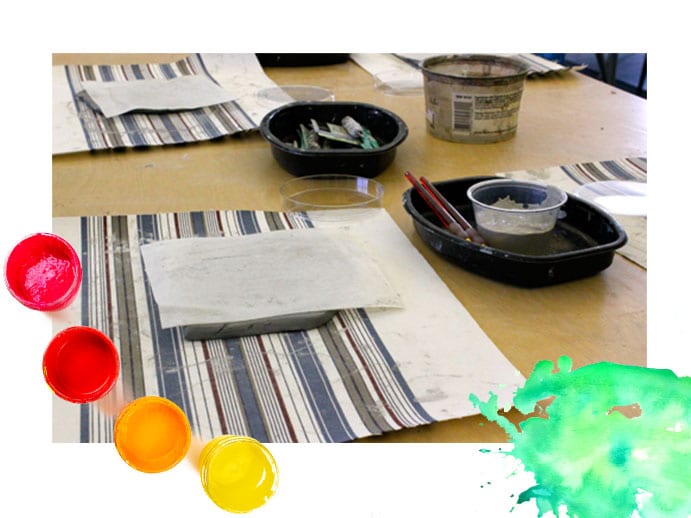
For ceramic projects, I used basic paper as well as tablecloths but found that tightly woven canvas or indoor/outdoor fabric works best. I found some Sumbrella fabric at a rummage sale, cut the bolt into squares and used them for years. Easiest clean-up ever!
WHAT YOU’LL LEARN:
– How to start going “back to basics” in the art room and why this can be beneficial for you and your students
– When and where not to use placemats in the classroom
– What you can do to creatively reuse your paper placemats
– What has, and hasn’t, worked for me with this project
LISTEN TO THE SHOW
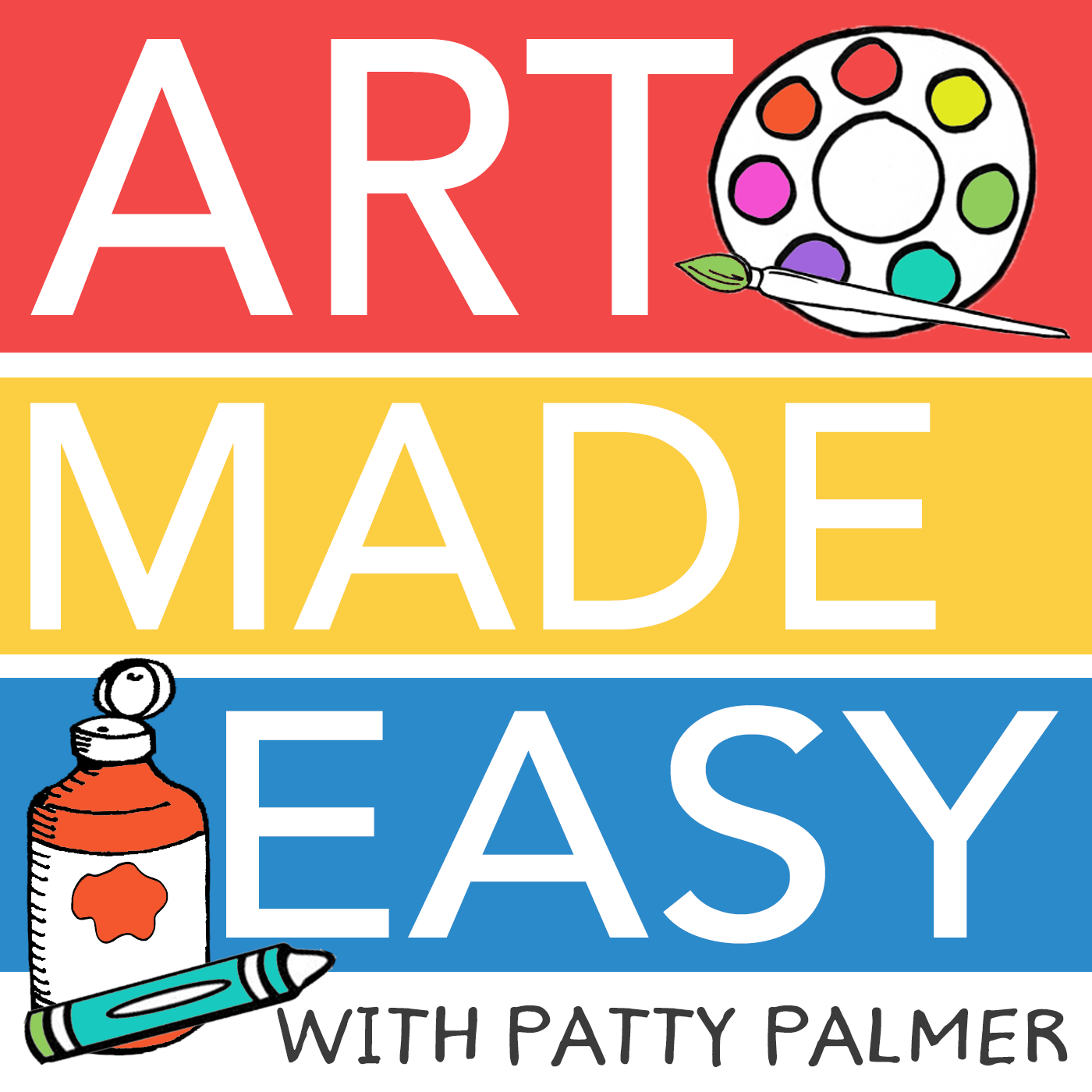
My best advice for teaching art to kids.
One of the small details that often gets overlooked in the art room is whether or not to cover your art tables during art class. You might be wondering:
What type of placemats work best?
Should the whole table be covered in paper? Fabric?
It took me a few years to figure out this placemat thing but when I did, it streamlined my prep and clean up substantially. Today’s episode answers a question from Katie inside the Deep Space Sparkle Facebook Group.
I thought it was such a great question, I decided to go a bit deeper, answering the WHY behind which placemat is best.
Katie asks, Does anyone have an inexpensive way to make clay mats? My budget for the year has been used up, so I’m looking for out-of-pocket affordable solutions. Any cheap and quick ideas?
I totally hear you, Katie!
This episode is for you and all the art teachers who are wondering:
– what type of placemats work best
– when to use placemats
– when NOT to use placemats
– best mats for clay and ceramics
Here’s what other teachers had to say to Katie’s question:
Fiona Coulter I use the cheap but sturdy blue paper drop cloths from the hardware store. One side is more plastic and the other side more paper like. I use the plastic side for clay and the paper side for any painting and drape them over the entire table grouping (8) desks. Works like a charm and lasts a long time.
Laurie O’Connell Longberry I use the plastic flexible cutting mats that you can get 3 for $1 at the dollar store. They last for years!
Tina Leggs Maloch I use a canvas drop cloth from Lowes and cut it into 10 x 12″ pieces – I have been using the same ones for 9 years and they work great.
I love the inexpensive version of using what I already have. At the beginning of the year, I would add an extra 50-100 sheets of 18″ x 24″ sulphite paper to my inventory order. This works out to be about $15. I found regular drawing paper works great for underneath most painting and coloring projects.
At the end of the year, I would take the paint-splattered placemats and cut them into strips and shapes. These because extra media for collage and paper projects for the following year.
For ceramic projects, I used basic paper as well as tablecloths but found that tightly woven canvas or indoor/outdoor fabric works best. I found some Sumbrella fabric at a rummage sale, cut the bolt into squares and used them for years. Easiest clean-up ever!
WHAT YOU’LL LEARN:
– How to start going “back to basics” in the art room and why this can be beneficial for you and your students
– When and where not to use placemats in the classroom
– What you can do to creatively reuse your paper placemats
– What has, and hasn’t, worked for me with this project
LISTEN TO THE SHOW
LINKS & RESOURCES
Tru-Ray Sulphite 18″ x 24″ paper
Watercolor Easter Eggs blog post
You can visit Patty through Deep Space Sparkle on Facebook and Instagram
Patty Palmer At Home Instagram
Join the Sparklers Club waitlist HERE
support@deepspacesparkle.com



LINKS & RESOURCES
Tru-Ray Sulphite 18″ x 24″ paper
Watercolor Easter Eggs blog post
You can visit Patty through Deep Space Sparkle on Facebook and Instagram
Patty Palmer At Home Instagram
Join the Sparklers Club waitlist HERE
support@deepspacesparkle.com

My best advice for teaching art to kids.
Yes, the day has come!
After a long time deciding if, I finally said when.
Thank you SO much for your encouragement, show suggestions and help getting Art Made Easy off the ground.
Many of you were so pumped about this show but confessed that you had no idea what a podcast was. I love you guys for your unbridled enthusiasm.
Here’s a quick definition of a podcast & what to expect from Art Made Easy:
A podcast is a free radio show. The host (me!) interviews guests or talks about a favorite subject. You get to listen through your computer, laptop or smart phone. I like to listen to my favorite podcasts in my car during long travel days or on my walks via set of ear buds and my iPhone.
You can subscribe to the show via iTunes and Stitcher radio. The benefit is that your free podcast ap on your iPhone will automatically be updated with all the podcast episodes from any show you subscribe to.
Go ahead and give it a try!
To listen on your laptop or computer, just click the play button in the colored box below.
To listen via iTunes, click on the “play in iTunes” banner and click subscribe.
And now onto the show…
For my first show, I wanted to tell you my story of how I became an art teacher. We all have different paths and this one is mine. I’ll share advice to those who are just starting out as an art teacher and some of my best tips for teaching art to kids.
This episode is for anyone who thinks they may not have the qualifications to be an art teacher. Teaching art to kids doesn’t have to happen inside a classroom. You can teach art at home, at a summer camp and even as a volunteer (like I did).
If you are an art teacher just beginning your journey, I’m sharing my best advice to get you through that tough first year. Download my free handout and keep it in your teacher planner and refer to it when you have a tough day.
LISTEN TO THE SHOW
SHOW NOTES:
Drawing With Children: A Creative Method for Adult Beginners, Too
Art Lab for Kids: 52 Creative Adventures in Drawing, Painting, Printmaking, Paper, and Mixed Media-For Budding Artists of All Ages (Lab Series)
National Art Convention
CreativeLive- free online classes
Art Teachers Facebook Group
Website: Painted Paper in the Art Room (Laura Lohmann)
Website: Art of Education
Book: Classroom Management for Art, Music, and PE Teachers
PS – Please leave a review on iTunes!
Art Made Easy is now live on iTunes! Subscribing to the show and leaving an honest review really helps the show gain visibility and allows me to tailor the show to your needs.














Yes, Patty, please more technical / practical info for the art room!! I always learn something helpful. That said, I’m a fan of *all the podcast topics* – Thank You ??!
I love these back to basic topics!! I am not a teacher and only volunteer once in a while to teach art. Every time I struggle with the prepping and how to set up the room effectively. These topics about the “basic” setup are very helpful.
I love your podcasts. I’ve been teaching art K-5 for 10 years and you have breathed new life into my teaching. Thank you for sharing so many of your tried and true methods with us.
You are so welcome Vicki!
I went to the Op Shop and bought some large old curtains and I use these on the tables as drop cloths when painting, gluing etc. They are backed so they are heavy enough to sit on the table and if dye spills it doesn’t go through onto the tables and spills don’t matter. They actually look really cool now as they have lots of coloured paint drips all over them. They are so easy to throw on and off the tables as needed.
I have been lucky with my first year at this school the after school program had these large yellow sheets of almost poster board but not as firm if that makes sense, just sturdier than regular drawing/painting paper but not hard or shiny and they are larger than the pages we paint/draw on. They didn’t need these for anything and I wanted something to put under projects, I use them as gluing paper, paint paper, anything messy they go under!. These are wonderful, I love paper place mats because they dry quickly and do not need cleaning, where an actual plastic mat would make for more clean up, the paper mats often go with the work on the drying rack or even are dry at the end of class and can simply be stacked up again for the next day. I too use canvas drop cloths cut into squares for clay, once in awhile give them a little wash and they are fine again, plastic will stick too much to the clay and paper will often come off in the clay so neither one works well.
Patty
I love your pod cast. I listen in my art room during prep time. It really does feel like a friend is in the room with me. I found a denim outlet in my town and they gave me lots large of scraps for free. I use them for my clay mats. I really enjoy any of the topics you put out.
Also I cant say enough how much becoming a member of the sparklers club has helped me. I have more time with my family. I feel like each grade gets awesome lessons every day. I get lots complements on the art work on the walls. I love your content from pod cast, lessons and tutorials. Thank YOU!!! have a wonderful day.
This warms my heart, Amanda. I’m SO happy that the content we create helps you so much. And while I love supporting you the classroom., to be able to give you more time with your family is priceless to me. Thank YOU!
Great ideas. My art table has carpet underneath what can I do to protect the carpet ?